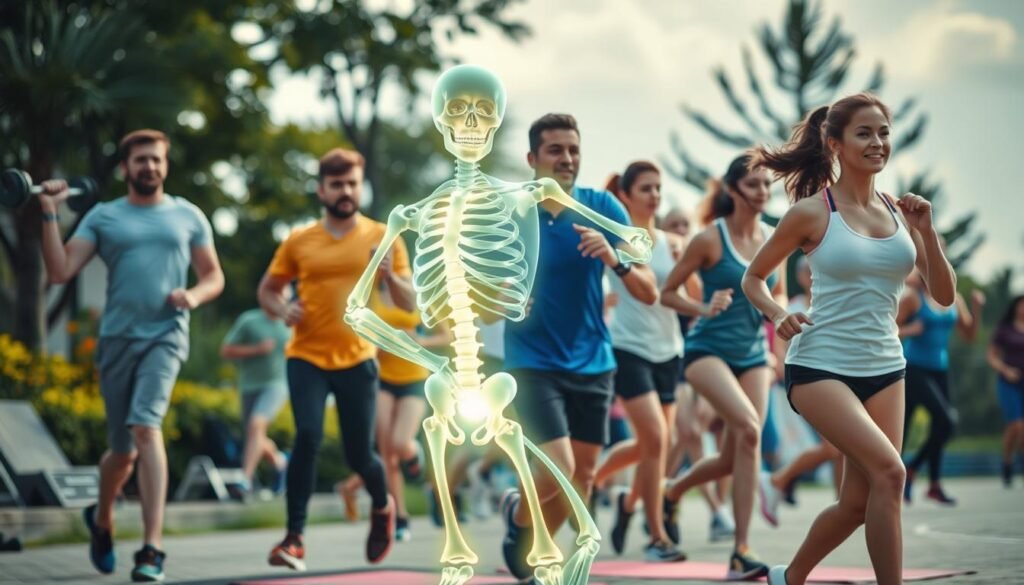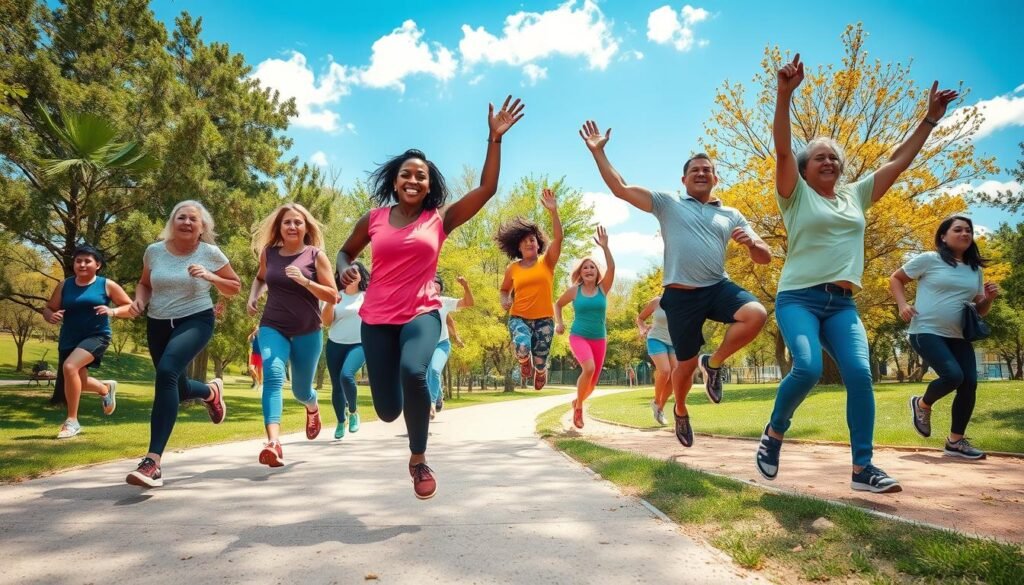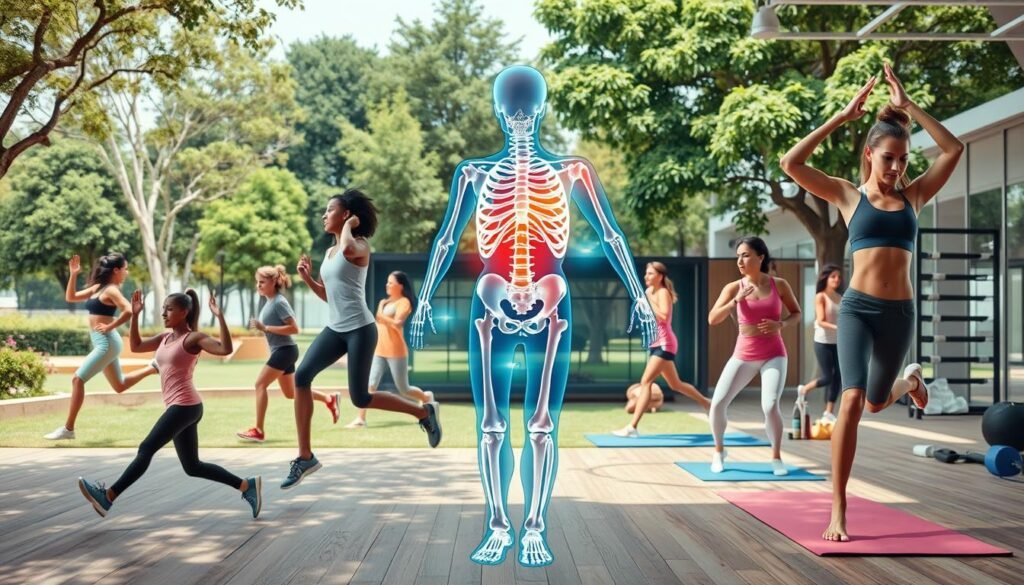Did you know that over 44 million people in the U.S. are at risk or have osteoporosis? This fact shows the need for us to care for our bone health. Being active is key in making bones stronger and lowering fracture risks, which is part of a healthy life.
It’s important for everyone to exercise regularly. This helps make our bones and skeleton stronger. Activities like walking, running, and dancing boost bone strength. Also, doing strength training every week is vital. It works on your muscles and bones, making them stronger.
Knowing how exercise helps our bones is powerful. It guides us as we get older, in preventing bone loss and osteoporosis. For more details on this topic, check out this research article.
Key Takeaways
- Physical activity is crucial for preventing osteoporosis and maintaining bone strength.
- Weight-bearing exercises like walking and jogging can significantly enhance bone density.
- Regular strength training helps target major muscle groups and supports bone health.
- Understanding personal risk factors for osteoporosis is essential for effective prevention strategies.
- Combining exercise with a balanced diet rich in calcium and Vitamin D promotes lifelong bone health.
Understanding Bone Health
Bone health is important for everyone, young and old. As we get older, it becomes even more critical. This is because our bone density, or bone strength, can change. Knowing what affects our bones helps us keep them strong.
What is Bone Density and Why It Matters
Bone density measures the minerals in our bones. It’s key for keeping bones tough and preventing breaks. Most people have the strongest bones around age 30. After that, bones may slowly get weaker. This can lead to osteoporosis, a condition where bones are fragile.
The Impact of Aging on Bone Strength
As we age, our bones can get weaker. For women, menopause can speed up bone loss due to less estrogen. Not moving enough, eating poorly, and smoking also hurt bone health. Knowing this helps us take care of our bones as we get older.
Risk Factors for Low Bone Mass
It’s important to know what could make bones weak. Being inactive or smoking can increase the risk of thin bones. Drinking a lot of alcohol is bad too. Women often have a higher risk than men. Having thin bones in the family means you might get it, too. If you’re very thin or use certain medicines for a long time, your risk goes up.
The Importance of Physical Activity for Bone Health
Being active strengthens bones and improves health. Regular workouts build bone mass in kids and young folks. For older people, it helps prevent osteoporosis, a condition that makes bones weak.
How Exercise Strengthens Bones
Exercise does more than build muscles. It also boosts bone density. Walking, running, and dancing trigger cells that make bones stronger. This is key up to age 35, as it’s when our bodies build up bones the most.
Studies show that doing physical activities like these for 30 minutes three times a week reduces the risk of falls and bone breaks.
Preventing Osteoporosis Through Regular Activity
Stopping osteoporosis starts with regular, weight-bearing exercises. These exercises are even more important for women, who are more likely to get the disease. Adding workouts like hiking, stair climbing, and jumping rope helps a lot.
| Age Group | Recommended Activity |
|---|---|
| 6-17 years | 60+ minutes of moderate to vigorous physical activity daily, including aerobic and strength-training |
| 18-64 years | 150-300 minutes of moderate exercise or 75-150 minutes of vigorous activity per week, plus strength training twice a week |
| 65+ years | Adult guidelines plus balance exercises, particularly if falling is a concern |
Choosing to stay active helps prevent osteoporosis. Effective exercising keeps bones strong for a long time.

Types of Exercises for Building Bone Strength
Staying active is key to strong bones. There are many exercises that offer great benefits. Weight-bearing and strength-training exercises are top choices for increasing bone density. Different exercises help our bones in unique ways. This helps us choose the best workout for our fitness goals.
Weight-Bearing Activities
Exercises that make you work against gravity are called weight-bearing activities. These activities help bones grow strong. Some examples are:
- Brisk walking
- Jogging
- Dancing (especially styles like salsa or tango)
- Team sports such as basketball and soccer
- Hiking, which improves hip density with less stress
Doing these kinds of exercises often improves bone density. The hips and spine benefit the most from them.
Strength-Training Exercises
Building muscles helps bones get denser, which is crucial. Including resistance exercises in your workouts fights bone loss as you age. It’s good to do strength training 2 to 3 times a week. Some good exercises are:
- Weightlifting
- Bodyweight exercises (e.g., squats, lunges)
- Resistance band routines
- Weight machines at gyms
Yoga and Pilates also strengthen your body with less risk of injury. They’re good for people with osteoporosis.
Low-Impact vs. High-Impact Activities
Choosing exercise types depends on your age, how fit you are, and if you have any health issues. Low-impact activities like walking and some yoga poses are gentle on your bones. However, high-impact exercises, such as running and jumping, build bone density faster. But, they also carry a higher risk of injury, especially if you’re not used to them.
Both low and high-impact exercises are important for bones. For example, nurses walking four hours weekly had a much lower risk of hip fractures. This shows the value of regular weight-bearing exercise.

Adding different exercises to your daily routine is great for bones. To get personal tips on avoiding bone injuries, check out more here. This could help your entire musculoskeletal system stay healthy.
Physical Activity and Bone Health
Being active has a big effect on bone strength. Moving regularly helps bones grow strong. If we don’t move enough, our bones can get weak. This makes it easier to get diseases like osteoporosis. Let’s see how exercise helps keep bones healthy.
Connection Between Activity Levels and Bone Density
Studies show moving more equals stronger bones. Exercises that make you carry your own weight or push against resistance are best. They help bones rebuild and stop them from getting weak as we get older. Right now, about 75 million people in places like the United States, Europe, and Japan have osteoporosis. This tells us we need to exercise more. Not moving enough can make bones thin. This is especially true when young people grow. They can get up to 90% of their strong bone mass by the time they are 18.
Exercise Recommendations for Healthy Bones
To keep bones healthy, follow these exercise tips. The American College of Sports Medicine says to do activities that make you bear weight 3 to 5 times a week. Adding strength-training helps make bones denser. Check out this table for the best types of exercise and their benefits:
| Exercise Type | Frequency | Benefits |
|---|---|---|
| Weight-Bearing Activities | 3-5 times per week | Improves bone density, reduces fracture risk |
| Resistance Training | 2-3 times per week | Increases muscle strength, enhances bone mineral density |
| Balance Exercises | Daily | Prevents falls and fractures |

Adding these exercises to your daily life really helps your bones. Exercising helps you reach your strongest bone mass. It also keeps your bones strong as you age. If you stay active, you’ll build a solid bone foundation for a healthy life.
Recommended Weight-Bearing Activities
Doing weight-bearing exercises is key for keeping bones strong as we get older. These workouts not only make bones stronger but also build muscle, cutting down the chance of osteoporosis injuries. Making exercise a part of your daily life can make a big difference.
Examples of Effective Weight-Bearing Exercises
There are many good weight-bearing exercises that can keep your bones healthy. Activities to consider include:
- Brisk walking
- Jogging
- Tennis
- Aerobic dance classes
- Resistance training with weights
However, swimming and biking are great for your heart but don’t help bones much. For people worried about bone health, it’s smart to carefully pick exercises that push your body a bit more.
Incorporating Weight-Bearing Activities into Daily Life
Enjoying your exercise routine helps make it a lasting part of life. Here’s how adults can do it:
- Set specific times for activity: Pick times each week for activities like speed walking or join a tennis club.
- Include physical activities in daily tasks: Walk instead of driving for short trips. Use stairs, not the elevator.
- Join community classes: Sign up for local classes that involve weight-bearing exercises.
- Encourage family involvement: Go for family walks or bike rides together.
Keeping up with weight-bearing exercises is essential for bone health. With the right plan and focus on being active daily, everyone can boost their strength and health.
Strength-Training Exercises: Building Muscle and Bone
Strength-training exercises are key for increasing muscle mass and bone density. People tend to lose muscle as they get older, raising the risk of osteoporosis. Doing resistance training like weightlifting and bodyweight exercises helps bones stay healthy.
Types of Strength-Training Exercises
There are several strength-training exercises that focus on different muscle groups. Here are some common ones:
- Weightlifting: Using weights helps boost muscle strength and grows bones.
- Bodyweight exercises: Push-ups and squats strengthen muscles without any equipment.
- Resistance bands: They add variety to strength training, whether you’re at home or at the gym.
Gaining muscle through these exercises helps with metabolism and everyday activities. It also protects joints and aids in keeping balance.
The Role of Resistance Training in Bone Health
Resistance training is great for bone health because it stresses the bones, which leads to stronger bone density. Research shows regular exercises can boost bone density by 1-2% in adults. Strength-training helps build stronger bones and muscles, making moving easier and reducing falls and fractures. Check out more on this at building bone and muscle.
Adding strength training to your week is advised, with at least two sessions that work all major muscles. Even short workouts of 20-30 minutes can greatly improve strength and how well you function. This makes strength-training a must for staying healthy.
| Exercise Type | Benefits | Frequency |
|---|---|---|
| Weightlifting | Increases muscle mass and bone density | 2-3 times a week |
| Bodyweight Exercises | Improves strength and functional ability | 3-4 times a week |
| Resistance Bands | Versatile and effective for home workouts | 2-3 times a week |
Doing strength-training regularly is great not just for muscles and bones. It also helps in maintaining a healthy weight and boosting metabolism. A balanced workout that includes resistance training and aerobic exercises improves bone health for life.
How Physical Activity Aids in Fall Prevention
Being active is key in preventing falls, especially for the elderly. Exercise boosts strength, balance, and coordination. This reduces the risk of falls, which can cause serious injuries.
Exercises that Improve Balance and Coordination
Older adults should do balance exercises to stay stable. Tai chi, Pilates, and strengthening the core help know where your body is in space. Here are some great exercises:
- Tai Chi: This martial art improves balance and flexibility with its slow moves.
- Single-leg stands: Balancing on one leg helps with stability.
- Heel-to-toe walking: This improves how well you move and coordinate.
Doing these exercises often makes you steadier and more confident in moving.
Importance of Fall Prevention for Older Adults
For seniors, avoiding falls is crucial to stay independent and safe. With millions affected by osteoporosis in the US, Europe, and Japan, falls are a big risk. Each year, fractures, especially hip fractures, lead to disability and a higher chance of death after the injury.
Exercise helps seniors move better and lowers the chance of falls. It’s also a budget-friendly way to treat osteoporosis, compared to medicines. Thus, staying active is essential for healthy bones.
To learn more about how exercise helps in preventing falls, check out this detailed study. It shows why being active is important.
Nutrition’s Role in Bone Health
Nutrition is key to keeping bones strong and healthy. We need enough calcium and vitamin D. These nutrients help keep bone density and health as we grow. For children and adults, getting enough calcium is a must. It’s found in dairy, greens, and some foods that are fortified. Vitamin D is just as important. It comes from the sun and foods like fatty fish.
Vitamin D helps our body absorb calcium. So, it’s vital for bone health.
Calcium and Vitamin D: Essential Nutrients
To have healthy bones, eat foods rich in calcium and vitamin D. People who don’t get enough of these may have weak bones. This can lead to more breaks. It’s also important to keep a healthy weight. Why? Because being too thin can increase the chance of bone loss and breaks.
How Diet Complements Exercise for Stronger Bones
A mix of diet and exercise is good for bone health. Exercise makes bones denser. This is even better with the right nutrition. Doing exercises like running when young helps build bone mass. For the best results, make sure to also eat foods high in needed nutrients. A good diet supports an active life. This is how to keep bones strong.
Want to know more about food and bone health? Check out this detailed article. It talks about how different factors affect bone strength.